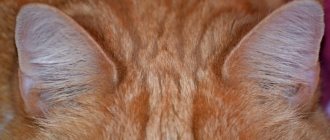Attachment to a pet has an applied and emotional side. A conscientious but reserved owner pampers the cat with treats, spares no expense on veterinary care, and does not forget to comb the cat’s fur and keep the litter box clean. Emotions prevail when a person is touched by photographs of a pet, strokes, squeezes and carries it in his arms, squeezes it in his arms and showers it with kisses. However, how safe is such close contact? Why do doctors, veterinarians and animal psychologists warn against excessive affection and kissing with four-legged animals?
Why you can't kiss cats and kittens
Among superstitious people who believe in mysticism, there is a widespread view that cats should not be kissed for the reason that this drains a person’s vital energy, which cannot always be fully replenished. However, the seriousness of the situation does not lie at all in some subtle matters. If something unwanted passes to the owner when it comes into contact with fur or saliva on the cat’s face, then these are cat microorganisms, not all of which are harmless. The point is not that not all cats are highly clean, unlike most representatives of their kind. Wool itself is an excellent “nursery” for various kinds of microorganisms, which means that when kissing, contact with them is inevitable.
Cat fur contains microorganisms, not all of which are harmless.
Is it possible to kiss domestic cats?
There is only one conclusion: kisses and close hugs are undesirable for either the pet or the cat’s owners.
Another source of concern is fleas, which can bite and even carry some diseases. Yes, if the cat is an indoor cat and does not go outside, then it most likely does not have insects (although the animal’s “homebody” does not give a 100% guarantee). But in addition to fleas, dust mites live in animal fur, invisible to the eye and causing severe allergies in many people. This is the very notorious “cat allergy”, which, according to the latest scientific research, does not exist. Or rather, it exists, but the cat has nothing to do with it, it’s not the animal at all, but the dust mites. Therefore, those prone to allergies should refrain not only from kissing, but even from bringing animal fur close to their face - this applies to those who like to tinker and sleep with cats as if they were soft toys.
Life cycle of a cat flea
Another source of trouble is cat saliva. Even with absolute confidence that the pet has been treated for parasites. The saliva of mammals contains a certain set of proteins characteristic of each species. When you kiss on the face, some amount of saliva necessarily enters the person’s oral cavity. And here questions may arise: where did the inflammatory processes come from, since the cat doesn’t go for walks, its owners regularly take it to the veterinarian to get rid of parasites? The fact is that the human immune system clearly perceives a foreign protein as hostile and immediately tries to neutralize it. As a result, immunity decreases for some time, but the risk of infection with all sorts of unpleasant ailments increases, the most harmless of which are gingivitis and stomatitis. This is why you can’t even kiss your pet pussies on the faces.
It is also better to simply stroke the sides and back, without kissing - the fur contains microorganisms that are “native” to the cat, but are completely alien to people and the immune system begins to reject them.
Video - Reasons why you shouldn't kiss cats
What do the doctor's say
If the situation with superstitions is ambiguous, then the medical reasons are much more compelling. There is an opinion that a clean and well-groomed pet cannot be a carrier of diseases. The cat is clean, vaccinated, and doesn’t go out for walks. There is some truth in this, but not everything is so rosy.
Even domestic cats can pose a threat to the human body. The most harmless consequences can be diseases of the oral cavity (gingivitis, stomatitis) or intestinal infection. Unpleasant surprises may also include:
- helminths;
- fungal diseases (for example, lichen);
- plague;
- toxoplasmosis;
- staphylococcus;
- “cat scratch” disease (rash, allergic manifestations).
Proper care of the animal, annual preventive examinations, vaccination and adherence to the rules of personal hygiene will help to avoid the above.
But it is still worth remembering the potential danger. People at risk include people with weakened immune systems, children, and pregnant women. Do you want to avoid consequences? Take precautions:
- do not kiss street or other people's animals whose health you are not well informed about;
- Wash your hands after close contact with an animal;
- do not allow your pet to walk on the dining table;
- carry out anthelmintic prophylaxis every 3 months;
- Wash water and food bowls thoroughly;
- Clean your cat's litter box every day, and wash your hands thoroughly after the procedure. For pregnant women who are not immune to toxoplasmosis, this issue is especially important. For the time being, it is better to delegate this responsibility to other family members.
What can you get infected by kissing cats?
So, it's clear that a kiss is not the best way to express your love for your furry pet. Among the “surprises” may await:
- Protozoa bacteria (they do not pose a danger to a person with a strong immune system).
- Staphylococcus (some types pose a threat to humans).
- Salmonella (very rarely cats act as carriers).
- Toxoplasmosis (the pathogen hides in the animal’s feces and, when released into the external environment, becomes passive and develops only under favorable conditions. The risk of getting sick is low if you wash your hands after cleaning trays, but it is better for pregnant women not to do this).
- Fungal infections, for example, ringworm (not dangerous to human life, but it will take a long and unpleasant time to fight).
- Helminths (tapeworms, nematodes, echinococci, roundworms).
The process of infecting a cat with worms
If a four-legged family member walks on the street, then this is even more dangerous - he catches birds and rodents, carriers of various kinds of viruses, including those dangerous to people.
Possible diseases
There are a number of diseases that a cat can infect humans by being a carrier.
Toxoplasmosis
This is an extremely dangerous parasitic disease transmitted through Toxoplasma, a protozoan single-celled organism.
Today, more than half the adult population of Europe, South and North America is infected—almost 90%. But humans are an intermediate carrier of the parasite. And the main carrier is all cat species. During the short period of the acute phase of the disease, they release from 2 to 3 billion oocysts. Parasites, along with animal feces, enter the environment and, after spirulation, can live in a preserved state for up to three years, waiting for a new carrier.
Cats usually tolerate the disease easily. And it manifests itself in short-term conjunctivitis and diarrhea. Small kittens with intrauterine infection and young animals, especially with concomitant viral infections, can die from toxoplasmosis.
For humans, a cat with toxoplasmosis is dangerous for a very short period of time during the acute phase of the disease and only if the parasite enters directly into the owner’s blood (for example, through bleeding scratches on the hand when the pet licks them). Or if by chance the cat sneezes in the owner’s face.
This is why you should never kiss an animal. In air, oocysts die immediately, and with direct mouth-to-mouth contact they can enter the human body through saliva.
Infection is especially dangerous for a pregnant woman, since there is a high probability of intrauterine infection of the child.
With daily cleaning of the cat litter, infection is impossible, since spirulation, that is, the readiness of Toxoplasma to enter the host’s body, does not occur immediately. This is possible no earlier than in a day (sometimes up to five).
Cat scratch disease - Felinosis
This disease has been known for a long time, but its mechanism was fully described only in the 90s of the last century.
Benign lymphoreticulosis or Molar granuloma is dangerous due to short-term inflammation of the lymph nodes. The disease is transmitted through scratches from a cat’s claws.
More than half of all cats in the world are carriers of Felinosis. Since the infection has been little studied, there is a possibility that the animal’s saliva may contain its pathogens. For this reason, kissing pets is also dangerous.
Pets themselves become infected with Felinosis through fleas. For this reason, it is important to regularly treat them for external parasites.
In a person, after infection, the disease develops over three stages; with sufficiently good internal reserves of the body, it proceeds easily (often asymptomatic) and recovery occurs on its own. The person who has recovered from the disease develops a strong immunity to Felinosis.
Salmonella
This is a zooanthropotic pathology that equally affects cats and humans. It is transmitted by infection of the body with Salmonella bacteria.
They are capable of surviving for up to 2-3 months on human furniture, clothing, and shoes. About six months - on food and excrement, in water and garbage. The bacterium easily tolerates sunlight and temperature changes. -85 ⁰C and +100 ⁰C are destructive for it. But effective disinfection can help get rid of the parasite within half an hour.
Salmonellosis is extremely difficult for newborn kittens and young animals to suffer from. Diarrhea and other dyspeptic symptoms appear, quickly leading to dehydration of the body.
For humans, this disease is also extremely dangerous and difficult to tolerate.
The cat usually gets sick within a day or three after infection. Therefore, kissing a pet is dangerous, in case it has already eaten infected meat and is currently transmitting the pathogen through saliva to its owner.
If any symptoms of pathology appear in a cat or a person, you should immediately contact a veterinarian and doctor. If treatment is carried out on time, consequences can be avoided.
Worm infestation
This disease is carried by a variety of parasitic worms. Refers to zooanthropotic diseases.
You can become infected through food, dirt, soil, feces, saliva of an infected individual, lice, fleas, and other external parasites.
There are a lot of types of worms, about 30 in Russia alone.
The best way to prevent your pets and household from getting helminthic infestations is timely deworming of your pets. Veterinarians recommend performing this procedure once every three months.
At the first signs of pathology, you must contact a specialist and begin treatment. The prognosis is positive.
When kissing a cat, infection can easily occur through saliva, because there is no guarantee that the animal is not infected.
Fungal infections
Ringworm is the most common zooanthropotic disease today, which is easily transmitted from cats to humans. But most often, on the contrary, the owner infects the pet and, without even knowing it, blames the animal.
The fungus can be brought into the house from the street on clothes and shoes, but a cat can easily pick it up at an exhibition or while walking outside. Dog paws are another source of infection.
Treatment methods for lichen today are effective, although the process will take at least a month for both humans and pets.
Hygiene practices must be followed to avoid infection. Kissing a cat, especially a stranger, is strictly prohibited.
There is currently no effective regular vaccine.
Rabies
This is one of the most dangerous diseases in the world, it is equally dangerous for both people and cats.
Rabies has been well studied and described. The salvation of humanity from this infection was the vaccine developed by Louis Pasteur.
It is recommended to vaccinate pets annually to prevent the possibility of infection. But you shouldn’t kiss your own pets, much less unfamiliar animals. In case of infection, any pets must be destroyed; a person in the initial stage can be saved by vaccination.
Do cats like to be kissed?
A logical question arises: how does the cat herself feel from hugs and kisses from her owner? Surprisingly, very few murks perceive this as affection and would like to receive it again and again. On the contrary, they see this as some kind of act of aggression and try in every possible way to avoid such a manifestation of feelings - they worry, hiss, and sometimes use their claws. It's simple - cats and people are not brothers and their ways of expressing emotions are completely different. If a cat responds to kisses with bites or scratches, this does not mean that it is aggressive or ill-mannered - it means that it has encountered an alien type of communication and does not understand how to behave. Or, on the contrary, she has already understood and clearly makes it clear to the person: “Stop it.”
Not every cat likes being kissed
Cat Kiss: Are you really kissed by your cats and pussies?
Cat owners are well acquainted with such characteristics of their four-legged charges as head-butting on the owner’s arms and legs, rubbing, touching with their paws, and light biting. Many people regard this as actual kissing, so why don’t they kiss the pussy in return?
In fact, such a manifestation of emotions has nothing to do with kissing. If a cat rubs against furniture, objects, bags, clothes, or the owner’s hands, then in no case does it express its submission as some people think and does not kiss. She marks the territory in this way, saying: “This is all mine, and the person is also mine, I allow him to be on my territory.” When a cat rubs, it spreads its scent throughout its habitat and divides those present into friends and foes.
Cats often lick. But this does not mean that they are kissing: the owner probably found the pussy tasty, because the aroma from the food remained on his hand or cheek. The same thing happens if a pet smells a new, unfamiliar scent - for example, the owner bought himself a new perfume. They will definitely come and rub and “tag” you. A cat can also lick a person if he doesn’t seem clean enough to her. The roots of this behavior lie in the instinctive desire of the mother cat to protect her brood from danger and rid it of foreign odors.
What does the cat say?
Important! In the same way, the cat examines pieces of furniture, sniffing them and tasting them with its teeth. However, no one thinks that she is kissing, for example, the sofa. Meanwhile, she studies a person in the same way. This is nothing more than a cognitive process, testing the teeth, studying properties. It has nothing to do with a kiss. Sometimes, by biting, a cat is forced, on the contrary, to stop the flow of affection from the owner. If he doesn’t understand, the cat scratches, bites and hisses. Some attribute this to an aggressive character, although in fact it is not the cat who is the aggressor, but she sees the owner as such.
All this does not mean that cats cannot kiss. They know how and practice. But they do this not through tactile contact, but at a distance. They squint their eyes, look at the owner, purring, sometimes turning on their back and sticking out their belly, demonstrating a high degree of trust in the person. Therefore, if you really want to please a cat (not from a human point of view, but from the point of view of the cat and its preferences), then the best kiss is to look at it gently, then slowly look away.
How cats show their love
Main reasons for the ban
Why pregnant women should not pet cats or have contact with them
To protect yourself and your health after squeezing your cat, you just need to wash your hands well with soap. This can protect a person from germs and bacteria that may be on the animal’s fur and saliva.
Important! The microbes themselves are not very dangerous until they are on the skin, but if they get into the mouth or mucous membranes, the consequences can be very unpredictable. There is no need to risk your health again.
Kissing cats is especially dangerous for children.
Doctors' concerns
Veterinarians and therapists unanimously recommend not kissing cats. Tactile contacts, and even more so kisses, should be left for your children, loved ones and relatives. For many, a cat is part of the family, but despite this, it belongs to a different biological species, which means that such contacts with it do not bode well, especially for children.
Sanitary and hygienic reasons
Unlike dogs, cats are very clean animals. They poop and pee in only one place, wash themselves several times a day, but all the fears are tied to the fur. It not only causes allergies in a certain circle of people, but is also a habitat for a huge number of microbes and parasites.
Important! If a cat is clean in appearance, this does not mean that it is not infected with any parasites and does not carry germs. Even indoor pets can carry dust mites.
In addition, a litter box-trained cat can still get its paws dirty with feces and urine, spreading it around the house. In such places, including paws, the concentration of microbes will be greatest. Tailed animals have good immunity, and if the pet itself is not sick, this does not mean that there are no pathogenic bacteria or parasites in its body.
There are a lot of bacteria and germs on a cat's paws.
Psychological reasons
Psychological reasons also exist. Over centuries of coexistence with animals, humans have become very attached to them. Unfortunately, he doesn't always know what they need. Excessive care has a negative impact on animals, and they grow up spoiled and are more likely to play pranks.
Mystical reasons
A long time ago, people thought that cats had a connection with the other world, and not with the best part of it. In the Middle Ages, it was believed that these pets were assistants to witches and sorcerers, who through them carried out their dirty deeds. Many were sure that if you kiss a cat, a person can become its slave. All the negativity towards the tailed ones disappeared over time. Cases of mass catching of plague rats by cats during the pandemic in Europe played a big role in this.
The benefits of communicating with cats
Scientists have proven that the benefits of communicating with furry pets are undeniable: even the very presence of a cat has a beneficial effect on the owner’s psyche, especially tactile contact when he picks it up and strokes it. In addition to purely moral satisfaction, communication with a pet improves well-being due to:
- activation of blood flow;
- warming the body, which is especially important during inflammatory processes and radiculitis;
- normalization of blood pressure and heart rate through activation of neurons from contact with cat fur.
The concept of feline therapy
In addition, it is noted:
- faster and more productive socialization of children with Down syndrome - constant contact with a cat makes it easier to get into contact with society;
- increasing stress resistance;
- quick relaxation after a busy day for all people, this is especially important for those whose work involves stress;
- getting rid of insomnia;
- reduction of symptoms of “chronic fatigue syndrome”, rapid fatigue disappears.
Thus, the benefits of tactile communication with your pet are undeniable. However, it should be remembered that it is impossible to force a cat to sit with its owner and treat him. The cat will leave if at the moment he did not plan to sit with the owner and purr. There will be no benefit from this, even if you forcibly hold the animal on your knees. It is better to wait until the cat is ready to do this.
Positive and negative effects of cats on human health
In a word, you can and should kiss cats, but at a certain distance. This is optimal contact for both four-legged animals and humans. The cat will feel that the owner loves her and respects her personal space, and the person does not need to be afraid of contracting unpleasant microorganisms or infections.
Attention! A cat and a person belong to different species, which means they have different languages and preferences, and you should not try to force animals to love you by forcibly hugging and kissing them.
You can watch a video on the dangers of kissing cats here:
Dangerous neighborhood
By receiving good nutrition and regular grooming, your pet can look completely healthy: well-fed sides, radiant eyes, shiny coat. However, it can be a carrier of pathogenic particles dangerous to humans, including viruses, bacteria, fungal microflora and parasites.
If a cat has access to the street and “walks on its own,” then the likelihood of bringing infection into the house on its paws and fur increases tenfold. Dirty travel through garbage cans and basements, eating garbage, contact with rats and unkempt stray creatures increases the risk of transmitting pathogens of dangerous diseases to owners:
- Rabies . The deadly virus usually enters the bloodstream through the bite of a sick animal. However, there have been cases of infection through saliva that gets onto the wound surface of the skin or mucous membrane. In the wild, the main source of the disease is foxes, and in the city - stray dogs and cats. The virus spreads along nerve fibers and affects the central nervous system, leading to aggressive behavior, paralysis and death. Veterinarians warn: you should never touch, much less pick up or press an unfamiliar cat to your face. The closer the site of initial penetration of the pathogen is to the head, the shorter the incubation period and the less time to take preventive measures and administer a life-saving vaccine.
- Toxoplasmosis . The causative agent of toxoplasmosis is the microscopic parasite Toxoplasma gondii, which enters the body through contact with infected animals, their blood, entrails and feces, as well as through eating poorly cooked or fried meat. If a pet is a carrier of toxoplasma, the owner can easily become infected by changing the litter in the cat's litter box and forgetting to wash their hands afterward. Some people have asymptomatic toxoplasmosis, while others experience a slight increase in temperature, conjunctivitis, lethargy, swollen lymph nodes, and dysfunction of the liver, heart, and nervous system. Toxoplasma poses a particular danger to pregnant women, causing intrauterine fetal death, serious developmental disorders and the birth of an oligophrenic child.
- Salmonellosis . This is a highly contagious infectious disease of animals caused by bacteria from the genus Salmonella and affecting mainly the digestive and respiratory systems. In young animals, the disease is severe, with general intoxication, fever, signs of acute gastroenteritis and bronchitis. A pet can become infected with salmonella through contact with sick pets, birds and harmful rodents. If sanitary standards are not observed at poultry farms, poultry carcasses and eggs become the source of the disease. A person runs the risk of getting salmonellosis by caring for a sick kitten or eating meat products that have not passed veterinary control.
- Chlamydia . In cats, the intracellular bacterium Chlamydophila felis most often affects the eyes, leading to chronic conjunctivitis. In babies from 1 to 3 months, severe inflammation of the mucous membrane of the eyes and profuse lacrimation are accompanied by decreased activity, runny nose, swelling of the throat and bronchitis. Mature cats become infected through sexual contact, newborn kittens - when passing through the female's birth canal. In humans, the course of feline chlamydial conjunctivitis has a lubricated form and proceeds easily. Infection is possible through contact with a carrier animal. For treatment, eye ointments containing antibiotics are used.
- Dermatomycoses . Fungal infections of the skin, known as ringworm, lead to redness, itching, dandruff, bald patches and brittle hair. The course of the disease is complicated by the addition of a pyogenic infection. Young children are most sensitive to dermatomycosis due to instability of the immune system and non-compliance with mandatory hygiene rules. If symptoms of the disease are detected in a cat, treatment should be started immediately, and all family members should undergo a preventive examination by a dermatologist.
- Helminths . Cats can be hosts to several types of parasitic worms (worms), which live primarily in the intestines, but cause intoxication of the entire body. Kittens are most often infected with roundworms (nematodes), the most common of which are roundworms. Their number can be so great that the intestinal wall ruptures and the baby dies from peritonitis. Adult animals are infested with tapeworms, the most dangerous of which is echinococcus. In the human body, the larva travels through the bloodstream into the liver and forms blisters there, in which it slowly develops and grows. Cats become infected with helminths from each other, or by eating raw meat, liver, or fish with microscopic larvae. Freshwater bodies of water are especially unfavorable, so it is recommended to thoroughly boil the catch from there. Worm eggs are released into the external environment with feces and often remain on the animal’s fur, so a person can become a carrier of helminths during daily interaction with a cat. As a preventative measure, you should regularly give your pet antihelminthic drugs and avoid feeding poor-quality food.











